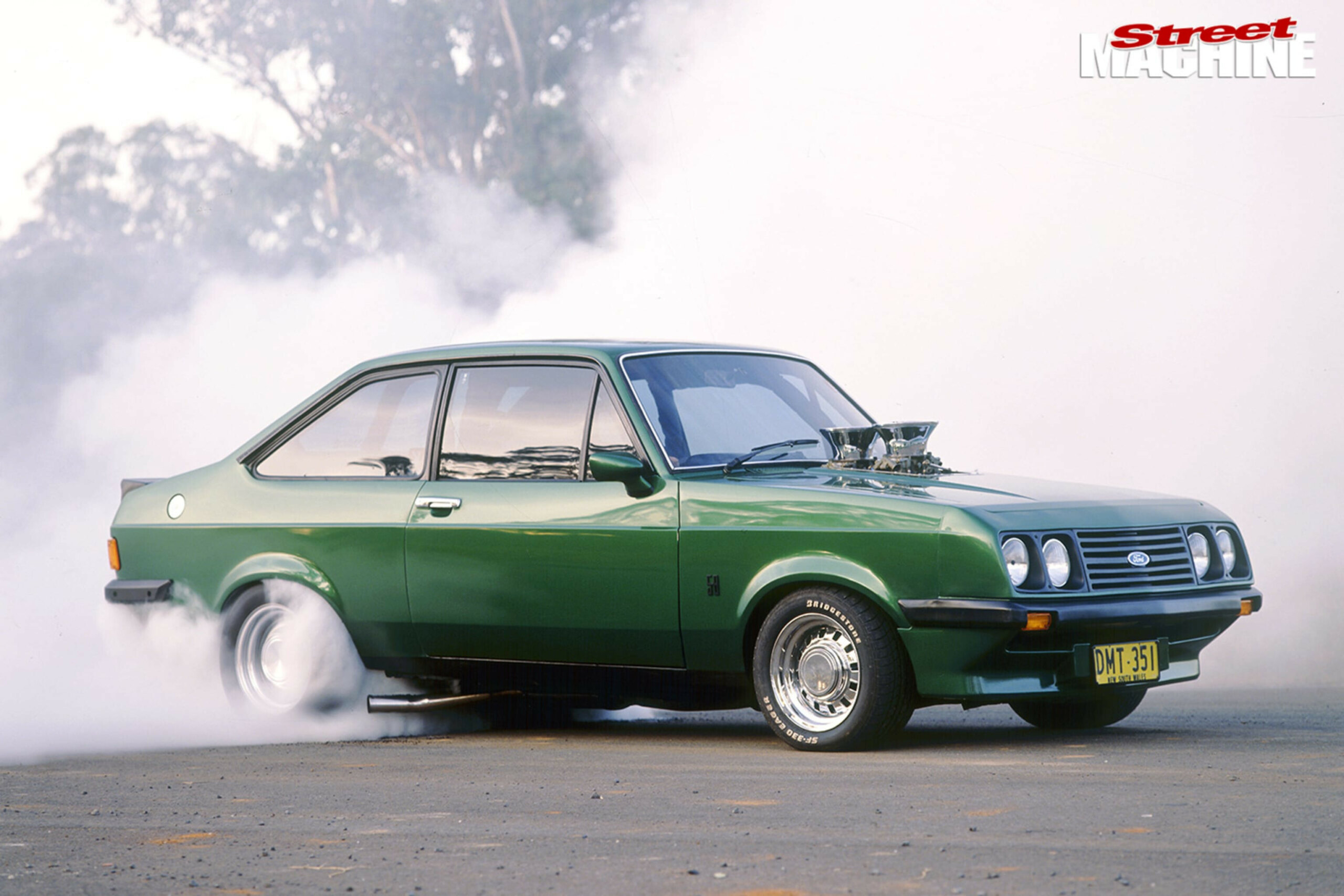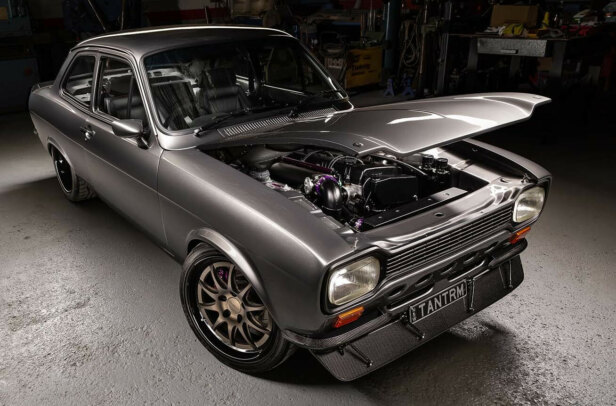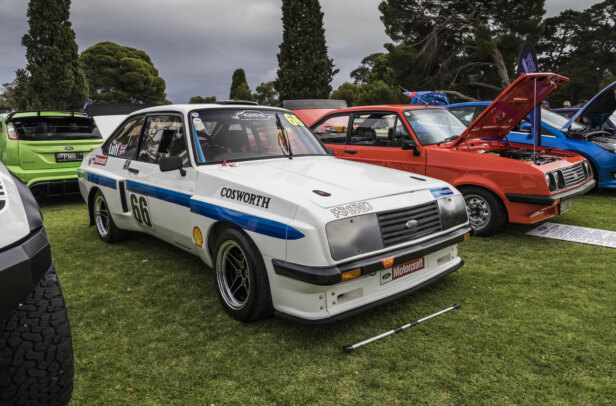In his early days, Mark Dall’Acqua punted two supercharged Falcons – a red-hot XT and later a solid-gold XT GT. Here’s a look back at one of his other toys, a rego-clean, 351-cube Escort
This article on Mark’s Escort was originally published in the January 1993 issue of Street Machine
NIT-pickers will notice this RS2000 Escort doesn’t quite look like a real one. But that’s okay, because it doesn’t go like one either. This one goes like no RS2000 ever did: 5.8 litres will beat 2.0 litres every time. That’s right, a street-legal RS5800, complete with Cleveland 351 and nine-inch.
Mark Dall’Acqua’s pretty well known around the traps of course with his big, bold gold Falcon, featured in the July-August ’88 issue of Street Machine. When he decided to build a ‘little’ car for fun, the Escort seemed a natural. Mark’s lean, green and oh-so-mean machine sets new benchmarks for righteous conversions.
For one thing, it’s 100 percent bona fide street legal; has been since getting its plates about 18 months ago. Mark was recently invited/requested to put the Escort over the pits again, just to check there hadn’t been any fiddles in the meantime. It was a case of status quo and another clean sheet, thank you officer.
The project didn’t begin with any old RS2000. Not an RS at all, in fact. Mark deliberately chose a ’75 model to pre-date the anti-pollution factors that came into effect midway through 1976. His is not just your average ’75, either. Mark found it was one of the very first off the production line, probably a tool-up car. It has more than the usual quota of spot welds along the seams.
In less time than it takes to tell, the original wheezy little four-banger got the flick and the firewall centre and forward tranny tunnel were opened up. In the course of floorpan mods, a 460mm-wide section was cut across the front floor from side rail to side rail just forward of the Escort’s crossmember. A matching piece of box-reinforced floor were fitted, the firewall and front pan were rebuilt for clearance.
In the interests of retaining reasonable front/rear weight distribution, the new drivetrain was mounted as far rearward as feasible without getting radical. Everything except the harmonic balancer and water pump is behind the front-axle line.
The V8 doesn’t sit on its original side mounts. Instead, Mark opted for an engine plate: a long, thick alloy plate that attaches to the front of the block, behind the timing cover. The ends of the plate carry rubber mounts that attach to brackets on the body shell’s side rails.
Apart from feeding the load straight into the chassis, instead of into a crossmember, the engine-plate system allows wide-open space between the engine sides and chassis, all the better to make room for the exhaust headers. Also contributing to the chassis front-end rigidity is a tubular cross-brace between the strut towers. The Escort rear crossmember was altered to accept the new gearbox mount.
It probably goes without saying that the engine’s a Ford, a 351 Cleveland. And hardly a stocker. Machined by Wilkins Performance of Girraween, west of Sydney, the block sports a heavy-duty 4MA crank running in Federal Mogul slippers and carrying ‘Bathurst’ rods with SPS cap bolts. Some blokes dispute the existence of Bathurst rods, but Mark is adamant and has the set to prove it: 100 thou thicker than standard, with a different big-end cap.
The rods are pinned to TRW pistons fitted with rings that Mark doesn’t care to identify. Similarly, while admitting that the cam is a Crane, he won’t specify its lift and timing. “Gotta have some secrets,” he says. The rest of the valve train’s an open book, with Crane solid lifters hoisting Manley 3/8in pushrods that actuate Yella Terra rockers that depress 4V Manley valves that are controlled by Isky coils.
The 4V closed-chamber heads were reworked by Wilkins Performance and included pushrod guide plates. Ports hogged out to storm-drain diameter were matched to their respective manifold which, for the inlets, is a Weiand 4V tunnel ram item topped by a brace of 650 Holley double-pumpers. Once ingested and squeezed, the mixture is sparked by a twin-point dizzy and Accel ignition.
Two cycles later the spent gas is delivered to mandrel-bent custom stainless-steel headers fabricated by Graham Piper. The 1¾-inch extractors dump into dual two-inch pipes that exit just ahead of the rear wheels.
Having opted for a Pete Jackson gear drive to run the cam, and knowing such systems are invariably noisy at idle, Mark tapped into an adjacent oilway and installed a squirt feed that doses the gears with extra lubrication to quieten the meshing teeth. Engine lubrication got its dues with a high-volume pump, remote filter and an oil-to-air cooler. Operating temperature is maintained by a custom radiator with a five-row core and two thermostatically controlled fans.
How much power? Plenty! There are no numbers, but a ton of grunt regardless. All of which is handled by a steel flywheel and 11-inch 3200lb Hays clutch. A heavy-duty combo, but in case the twain should part they’re wrapped in a Lakewood scatter shield.
The transmission is basically your usual four-speed TopLoader given the benefit of a couple of mentionable mods. For one thing it has a liberty-cut second gear, meaning the engaging dogs are eased to allow a slick clutchless grab when powering through the first-to-second shift.
Drive is transmitted via a Phase III-type prop shaft, the kind with bigger’n usual uni joints. Next along the driveline is a nine-inch rear end that runs 3.7 gears, 31-spline axles and a Detroit Locker diff.
The rear axle is carried on custom leaf springs, 1¾ inches wide instead of 2½ inches like the originals. But there’s an extra, reverse-arch leaf to stiffen up the spring rate and resist wind-up. Varying the location of aluminium spacers between the main leaves provides some adjustability of the springs’ behaviour, which can be further tuned by altering the settings of the Koni dampers.
The Escort’s upgraded front suspension also features Koni struts with heavy-duty coils and anti-roll bar. There’s no percentage in starting something you can’t stop, so the RS5700’s brake system’s a bit special. Whereas the rear end relies, capably enough at present, on XY GT drum brakes, the front has vented discs from the RS3100 Capri. They’re squeezed by pairs of the original-type calipers, one ahead of the strut, the other behind.
Big binders are only half of this Escort’s braking story, however, because what prods them into action is an aluminium Tilton pedal that operates dual master cylinders via an adjustable balance bar. The bar alters the bias between the separate front and rear brake systems. There’s no outside assistance, no booster. Instead, the pedal is a rocker type (with the pushrod above the pivot point) giving a 5.5:1 leverage ratio.
How’d the steering column clear the wider engine? Easy: the rack and pinion unit wasn’t touched but the bottom of the column was moved 100mm sideways. The difference was accommodated, after a bit of fiddling, with a new intermediate U-joint to tie the column to the pinion input.
The steering’s manual of course and, while not for seven-stone weaklings, isn’t quite as heavy as you might imagine with the bigger engine and 215/50R13 Bridgestone Eager tyres on seven-inch 12-slotter wheels. The same combo features at the other end, upped to 265/50R14 rubber on 10-inch rims.
The interior has a neat, conservative, high-quality air to it thanks to a pair of Scheel buckets and a complete retrim in black cloth by Woody’s Auto Upholstery. To keep up appearances while adding stiffness and safety, the six-point roll cage is fully padded. A Formuling sports wheel, extra gauges and an Alpine sound system complete this fast Ford’s furnishings, but not this story. Mark’s thinking about another engine, stashed away in the corner. It runs injection and a 6/71 GM blower.
MARK DALL’ACQUA
1975 FORD ESCORT RS2000
Featured: January 1993
Colour Wattyl Emerald Fire Mint
ENGINE
Engine: 351ci Cleveland
Induction: Twin Holley 650
Intake manifold: Weiand 4V tunnel ram
Heads: 4V closed chamber
Cam: Crane
Pistons: TRW
Crank: 4MA
Ignition: Accel racing
Exhaust: 1¾in extractors; 2½in dual
BENEATH
Trans: TopLoader
Diff: Nine-inch
SUSPENSION & BRAKES
Springs: Lovell
Shocks: KYB
Brakes: RS3100 vented discs (f), XY GT drums (r)
ROLLING STOCK
Tyres: Bridgestone Eager 215/50 (f), 265/50 (r)
Wheels: 12-slotters 13×7 (f), 14×10 (r)




Comments